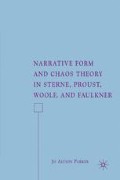Abstract
Like Mrs. Dalloway, William Faulkner’s Absalom, Absalom! deals with a minimal number of plot events. One hot afternoon, Quentin Compson listens to Miss Rosa Coldfield tell the story of the Sutpens; that evening he listens to his father fill in gaps in Miss Rosa’s story; and, six months later at Harvard, he and Shreve McCannon stay up all night piecing together the rest of the puzzle. The only events taking place in the present are instances of storytelling, and the one present-day action scene—Quentin’s journey with Rosa to Sutpen’s Hundred—comes to us only through a flashback. Like Virginia Woolf, however, William Faulkner attempts to convey “everything, everything!” within certain constraints. Instead of a drawing on a roving trajectory of focalization, he focalizes the overall narrative through various internal narrators in turn, and each narrator contributes to the emerging pattern of the Sutpen story.
Maybe nothing ever happens once and is finished. Maybe happen is never once but like ripples maybe on water after the pebble sinks, the ripples moving on, spreading, the pool attached by a narrow umbilical water-cord to the next pool which the first pool feeds, has fed, did feed, let this second pool contain a different temperature of water, a different molecularity of having seen, felt, remembered, reflect in a different tone the infinite unchanging sky, it doesn’t matter: that pebble’s watery echo whose fall it did not even see moves across its surface too at the original ripple space to the old ineradicable rhythm.
—Quentin Compson in Absalom, Absalom!
But now we discover an abundance of systems whose behaviour, although governed by precisely-known laws, cannot be predicted even in principle because they are so unstable. To know the law is not necessarily to know the behaviour.
—Michael Berry, “Chaology: The Emerging Science of Unpredictability”
Access this chapter
Tax calculation will be finalised at checkout
Purchases are for personal use only
Preview
Unable to display preview. Download preview PDF.
Notes
Peter Brooks, 308, 304. For a discussion of the text along the lines of Brooks’s, see also Karen McPherson, “Absalom, Absalom!: Telling Scratches,” Modern Fiction Studies 33 (1987): 431–50.
Joseph R. Reed, Jr., argues that the text “is a narrative about narrative,” Shreve and Quentin “replac[ing] the facts they are given with assumptions that better fit their developing design.” See Faulkner’s Narative (New Haven: Yale University Press. 1973), 47.
Ian MacKenzie, “Narratology and Thematics,” Modern Fiction Studies 33 (1987): 543, 544.
Susan Sniader Lanser, Fictions of Authority: Women Writers and Narrative Voice (Ithaca: Cornell University Press, 1992), 4.
Although his overall argument differs from mine, James A. Snead makes a connection between narrative withholding and the suppression of the black blood in “The ‘Joint’ of Racism: Withholding the Black in Absalom, Absalom!,” William Faulkner’s Absalom, Absalom!, ed. Harold Bloom (New York: Chelsea House Publishers, 1987), 129–41. Applying a chaos-science model to Go Down, Moses, Paul Harris points out that “the elegant balance struck between order and disorder” in Faulkner’s text “is a product and expression of larger historical and ideological forces.” See “Fractal Faulkner: Scaling Time in Go Down, Moses,” Poetics Today 14 (1993): 643.
James P. Crutchfield, J. Doyne Farmer, Norman H. Packard, and Robert S. Shaw, “Chaos,” Scientific American December 1986: 47–48.
William Faulkner, Absalom, Absalom!, The corrected text (1936; 1986; New York: Vintage International, 1990), 211–12. Further references to this edition are included in the text. Italicized words and passages are Faulkner’s unless I indicate otherwise.
The definition comes from Hayden White. See “Narrativity in the Representation of Reality,” The Content of the Form (Baltimore: Johns Hopkins University Press, 1987), 5.
See Faulkner’s Revision of Absalom, Absalom!: A Collation of the Manuscript and the Published Book (Austin: University of Texas Press, 1971). Critics often attempt to provide a rational explanation for Quentin’s and Shreve’s apparently sudden accession of knowledge by arguing that Henry Sutpen told Quentin of Bon’s black blood during the visit that Quentin made to Sutpen’s Hundred. See, for example, Michael Millgate, The Achievement of William Faulkner (New York: Random House, 1966), 164.
Faulkner admired both Sterne and Proust. In a letter to H. L. Mencken, he mentions that the American Language Supplement is “good reading, like Sterne or Swift.” See William Faulkner, “To H. L. Mencken,” 22 February 1948, Selected Letters of William Faulkner, ed. Joseph Blotner (Franldin Center, PA: Franldin Library, 1976), 324. In his biography of Faulkner, Blotner describes some of the points Faulkner made in an interview with a French doctoral candidate: “When he had read Proust’s À la Recherche du Temps Perdu, he said, ‘This is it!’ and wished he had written it himself.”
See Joseph Blotner, Faulkner: A Biography(1 vol.) (1974; New York: Vintage, 1984), 562.
Copyright information
© 2007 Jo Alyson Parker
About this chapter
Cite this chapter
Parker, J.A. (2007). Narrating the Indeterminate: Shreve McCannon in Absalom, Absalom!. In: Narrative Form and Chaos Theory in Sterne, Proust, Woolf, and Faulkner. Palgrave Macmillan, New York. https://doi.org/10.1057/9780230607217_5
Download citation
DOI: https://doi.org/10.1057/9780230607217_5
Publisher Name: Palgrave Macmillan, New York
Print ISBN: 978-1-349-53932-1
Online ISBN: 978-0-230-60721-7
eBook Packages: Palgrave Literature & Performing Arts CollectionLiterature, Cultural and Media Studies (R0)

